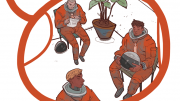*A shadowy figure walks down a dark alley. As they look over their shoulder, ensuring they are alone, a netbook is removed from a pocket, unfolded and plugged into a wall.
Within moments a file transfers between the thumb-drive embedded in the brickwork and the small computer; after unplugging the netbook and folding it up, the figure carries on, no one the wiser.*
While the above scenario sounds like something out of a spy novel, it’s actually an integral part of a new art project called “Dead Drops,” which the artist describes as an anonymous, offline, peer-to-peer file-sharing network.
A Dead Drop simply consists of a USB flash drive, which is permanently embedded in a wall or other solid structure. When the drive is originally placed the only thing that is on it is a text file, describing the project and explaining how to use the Dead Drop. Ideally, as people discover and use the drops they will take and leave files, similar to downloading from peer-to-peer networks.
The project was started by Aram Bartholl, an EYEBEAM artist-in-residence in New York, who promotes it via his website, DeadDrops.com.
According to Bartholl’s manifesto, anyone can create a Dead Drop as long as they follow the directions on his website and adhere to some simple rules.
Dead Drops:
1) Must be located in a public space that is always open
2) Must be embedded in such a way that you can access them without wires or special equipment
3) Must be readable and writeable by anyone
By creating your own Dead Drop you can add to Bartholl’s project and become part of the piece, which so far boasts 37 drops spread throughout the U.S., Canada, Australia and Europe.
With even legitimate peer-to-peer file sharing becoming increasingly scrutinized, this low-tech approach is refreshingly simple and honest, not to mention thrilling . . . since it allows you to play out scenes from Tom Clancy novels.



